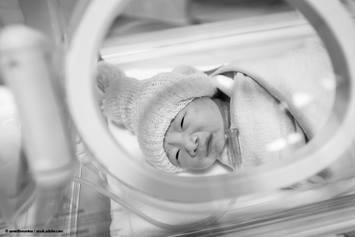Gastroesophageal Reflux Disease (GERD) in Infants
Gastroesophageal reflux is when your stomach acid goes back up into your throat. It can cause heartburn, chest pain, and trouble swallowing. It can be treated with medicine and lifestyle changes.
What Is Gastroesophageal Reflux Disease in Infants?
The esophagus is the tube that goes from the throat to the stomach.
Gastroesophageal reflux (GER) occurs when contents that have gone down to the stomach come back up into the esophagus.
Throwing up (vomiting) or food coming up into the mouth (regurgitation) may happen.
- GER is common in infants because they have a liquid diet and spend a lot of time lying down. They may outgrow this as they get bigger.
- If GER is more severe and longer lasting, it is called gastroesophageal reflux disease (GERD).
- If GERD isn't treated, your baby may not eat well or gain weight. It can also cause symptoms like coughing, noisy breathing, and vomiting.
What Causes Gastroesophageal Reflux Disease in Infants?
After food is swallowed, it goes through the esophagus to the stomach. There is a ring-shaped muscle at the bottom of the esophagus called the lower esophageal sphincter (LES).
The LES opens to let food into the stomach. After that, it stays closed so food does not come up into the esophagus.
- For some babies, their LES muscle doesn’t close or opens when it shouldn’t.
- If there is a problem with the LES, milk or formula and stomach juices (acid) can come back up into the esophagus and may be vomited. This can irritate the esophagus and may cause pain.
What Are Signs and Symptoms of GERD in Infants?
Your baby may have GERD if they:
- Are not gaining weight.
- Have a hard time eating or swallowing.
- Will not eat.
- Have blood, or green or yellow fluid in their vomit.
- Are having breathing problems like wheezing, on-going cough, or trouble breathing.
- Cough or wheeze so much that it wakes them up.
How Is GERD Diagnosed in Infants?
- A doctor or health care provider can usually diagnose GERD based on your baby’s symptoms.
- Your baby may be referred to a stomach doctor (gastroenterologist).
- A doctor or health care provider may order these for your baby to diagnose GERD:
- Upper gastrointestinal (GI) endoscopy – A small, flexible tube (catheter) with a camera on the end is used to see the inside of the esophagus and stomach.
- Esophageal pH-impedance monitoring – A catheter is put in your baby’s nose. It goes from their esophagus, down to their stomach. It is attached to a monitor that measures the amount of acid or non-acid reflux that goes into their esophagus.
- Upper GI series – An X-ray is done using a liquid, called barium, to view the upper GI tract. This lets the doctor or health care provider see the structures inside your baby’s body. It is not used to diagnose GERD.
How Is GERD Treated in Infants?
Lifestyle changes
Your baby’s doctor or health care provider may suggest making these lifestyle changes to help with their symptoms:
- Change their diet
- Do not smoke around them
- Burp them more often
- Hold them upright for 20 to 30 minutes after they eat
- Place them on their back to sleep. Your baby should always sleep on their back.
Medicines
Your baby’s doctor or health care provider may order medicine for GERD if lifestyle changes aren’t working. The medicine help block and lower the amount of stomach acid. They are not approved by the FDA for GERD. Only use the medicine ordered by the doctor if tests show there are acid-associated problems in the esophagus.
Surgery
Surgery isn’t suggested often for babies. They will most likely outgrow GERD by the time they’re 18 months of age.
What To Do at Home
- Do not over-feed your baby. Feeding your baby too much can make reflux symptoms worse. Their doctor or health care provider will tell you how much they should be eating with each feed. If vomiting or reflux symptoms occur, give less at each feeding.
- Feed your baby about every 2 to 4 hours during the day, and on demand at night (when your infant wakes up) or as directed by their doctor. Some infants need to be fed during both the day and night to gain weight.
- Your baby’s doctor may have you feed them thick formula to help decrease the reflux.
Safe Sleep Environment
- The crib you use must be safety-approved with a firm mattress and a close-fitting sheet.
- Place your baby on their back during sleep. The side is not a safe position, as babies can roll. The mattress should be flat, so their head is not raised. Your baby’s doctor may give other suggestions for sleeping positions based on their health needs.
- When your baby is in bed, all side rails must be up.
- Your baby’s crib must be in a smoke-free area.
- Always use the correct car seat for all travel. When not traveling, do not leave your baby in a car seat to sleep. This can make reflux symptoms worse.
- When using things like baby slings and bouncy seats, monitor your baby at all times. Look for for correct positioning and symptoms of reflux.
When to Call the Doctor
Call your baby’s doctor or health care provider if they:
- Lose weight or fail to gain weight.
- Have streaks of blood in their vomit.
- Have breathing problems, like a hard time breathing, their breathing stops, or they turn blue.
- Have a fever over 100° Fahrenheit (F) or 37.8° Celsius (C) when taken under their arm.
- Seem to be in pain.
- Are crying and can’t be calmed.
- Vomit half of their feeding or medicine more than one time.
- Vomiting of feeds gets worse.
- Show signs of dehydration:
- Urine is very dark
- Newborn (0 to 4 months of age) has less than 6 wet diapers per day
- Child (4 months or older) has less than 3 wet diapers per day or pees less than 3 times per day
- Does not pee at all
- No tears when crying
- Sunken-looking eyes
- Dry or sticky mouth
- Hard or fast breathing
- Soft spot on a baby’s head is flat, sunken, or pulls in
- Bellyache (abdominal pain) that will not go away
- Hard to wake up (lethargic), acts confused, or does not know what they are doing
- Urine is very dark
Helping Hands Patient Education Materials
Written and illustrated by medical, nursing and allied health professionals at Nationwide Children's Hospital, Helping Hand instructions are intended as a supplement to verbal instructions provided by a medical professional. The information is periodically reviewed and revised to reflect our current practice. However, Nationwide Children's Hospital is not responsible for any consequences resulting from the use or misuse of the information in the Helping Hands.
HH-I-96 | ©1989, revised 10/22, Nationwide Children’s Hospital



